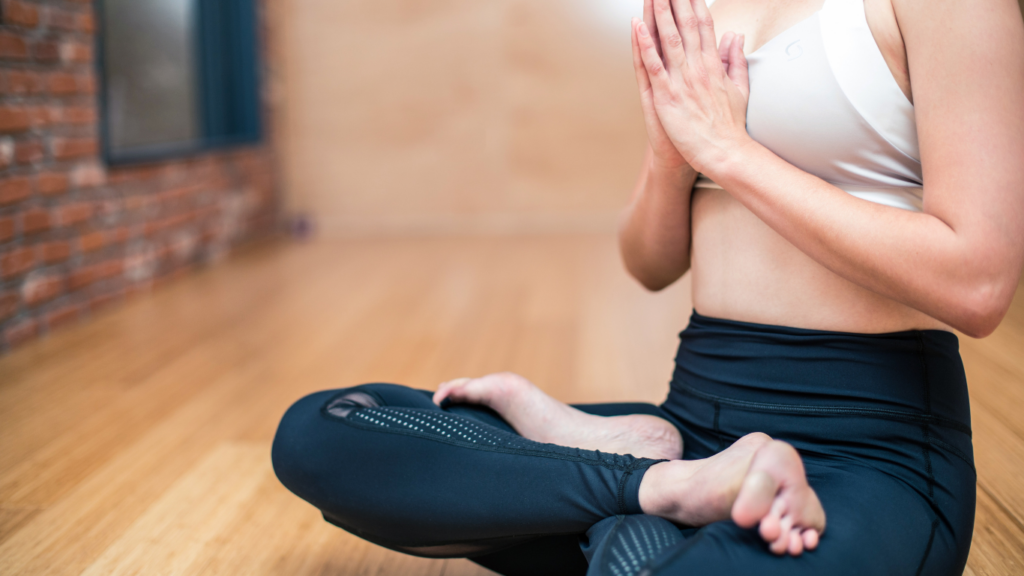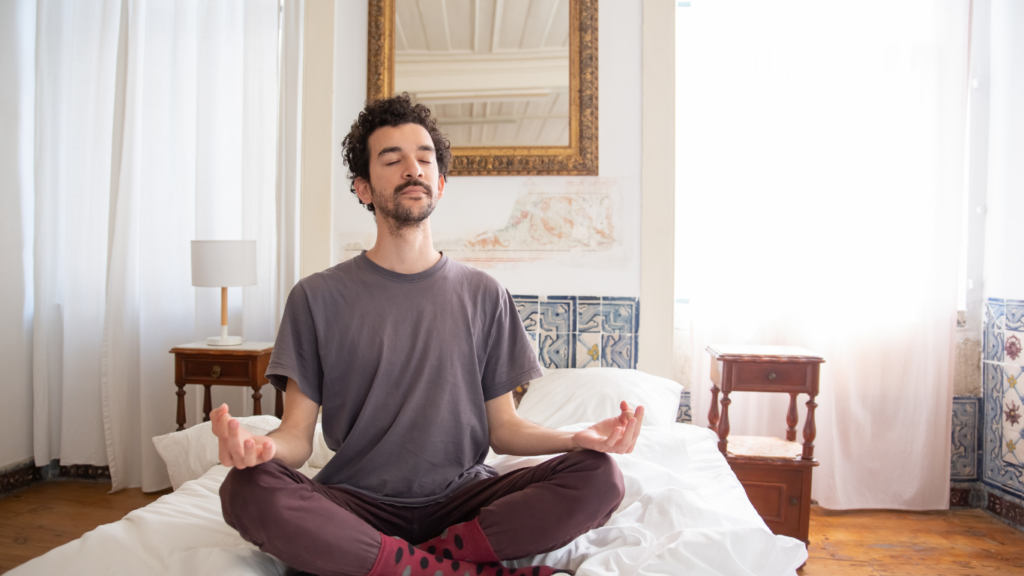Understanding the Basics: Yoga and Meditation
What Is Yoga?
When it comes to yoga, it’s a centuries-old practice originating in ancient India that focuses on physical postures, breathing techniques, and meditation to promote overall wellness.
Yoga isn’t just about stretching; it’s a holistic approach that combines body, mind, and spirit.
It’s popular worldwide for its ability to improve:
- flexibility,
- strength
- mental clarity
- improve sleep
- boosts mood
- ease anxiety
What Is Meditation?
Meditation, on the other hand, is a mindfulness practice that involves focusing the mind and eliminating scattered thoughts to achieve a sense of peace and clarity.
It’s about being present in the moment and cultivating a deep awareness of oneself and the surroundings.
Meditation is known for its profound benefits in reducing stress, enhancing concentration, and fostering emotional balance.
By incorporating yoga and meditation into daily life, individuals can experience a profound transformation in their overall well-being.
The Physical Benefits of Yoga
1. Enhanced Flexibility and Strength
Engaging in regular yoga practice has significantly enhanced my flexibility and strength
Through various yoga poses like the downward dog and warrior poses, I’ve noticed a remarkable increase in my flexibility over time.
These poses have not only helped me stretch my muscles but also build strength in different muscle groups.
The combination of flexibility and strength gained through yoga has improved my overall physical performance and reduced the risk of injuries in my daily activities.
2. Improved Respiratory Function
Yoga has played a pivotal role in improving my respiratory function. The focus on deep breathing techniques during yoga sessions has enhanced my lung capacity and respiratory efficiency.
By practicing pranayama, a yogic breathing exercise, I’ve learned to control my breath and increase oxygen flow to my body.
This conscious breathing not only calms my mind but also improves the efficiency of oxygen exchange in my body, leading to better overall health and vitality.
3. Better Balance and Posture
One of the most noticeable benefits of incorporating yoga into my daily routine has been the substantial improvement in my balance and posture.
The various standing and balancing poses in yoga, such as tree pose and eagle pose, have helped me strengthen my core muscles and stabilize my body.
As a result, my posture has become more aligned, reducing strain on my muscles and joints.
The enhanced balance and posture from yoga practice have translated into better body awareness and coordination in my everyday movements.
The Mental Benefits of Meditation

1. Stress Reduction and Relaxation
Meditation is a powerful tool for stress reduction and inducing relaxation.
By engaging in regular meditation practices, one can effectively lower their stress levels and promote a sense of calmness in daily life.
Through techniques such as mindfulness meditation, individuals can learn to control their thoughts and emotions, leading to reduced anxiety and overall relaxation of the mind and body.
2. Increased Focus and Concentration
One of the key benefits of meditation is the enhancement of focus and concentration.
By training the mind to stay present and attentive during meditation sessions, individuals can carry over this heightened focus to their daily tasks and activities.
Improved concentration leads to increased productivity, better decision-making, and a sharper awareness of surroundings, ultimately boosting overall cognitive performance.
3. Emotional Balance and Well-being
Meditation plays a significant role in cultivating emotional balance and promoting overall well-being.
By practicing meditation regularly, individuals can develop a deep sense of self-awareness and emotional regulation.
This awareness helps in managing and navigating through various emotions, leading to a more stable and positive state of mind.
Additionally, meditation fosters a sense of inner peace and contentment, contributing to improved emotional resilience and well-being.
The Holistic Advantage
Connecting Mind, Body, and Spirit
Focusing on the holistic advantage of yoga and meditation, I see the profound connection they establish between the mind, body, and spirit.
Through the practice of yoga postures and meditation techniques, individuals can align their physical movements with their mental state, creating harmony within themselves.
This synchronization promotes a sense of unity and balance, allowing practitioners to tap into their innermost being and cultivate a deeper understanding of themselves.
The holistic approach of yoga and meditation not only enhances physical well-being but also nourishes the soul and spirit, leading to a more profound sense of fulfillment and inner peace.
Lifestyle Changes and Longevity
Incorporating yoga and meditation into my daily life has shown me the transformative power of these practices in promoting longevity and overall well-being.
By embracing a lifestyle centered around yoga and meditation, I’ve experienced positive changes in both my physical health and mental clarity.
These practices have not only helped me manage stress more effectively but have also enhanced my overall quality of life.
The longevity benefits of yoga and meditation extend beyond the physical realm, as they contribute to emotional balance, cognitive sharpness, and a profound sense of inner peace.
Embracing these lifestyle changes has been instrumental in fostering a holistic approach to well-being and promoting a fulfilling and vibrant life.
Implementing Yoga and Meditation into Your Routine
Establishing a Daily Practice
To begin incorporating yoga and meditation into my routine, I find it helpful to start with small, manageable steps. I make a commitment to myself to devote a few minutes each day to these practices.
Each morning, before the hustle and bustle of the day begins, I set aside time for a brief yoga session to stretch my body and focus my mind.
Following this, I sit in meditation for a few moments to center myself and set intentions for the day.
Consistency is key when establishing a daily practice. I ensure that I carve out this time in my schedule every day, treating it as non-negotiable self-care.
By making it a priority, I reinforce the habit of incorporating yoga and meditation into my routine, reaping the benefits of improved focus, reduced stress, and enhanced well-being throughout the day.
Overcoming Common Challenges
One common challenge I face when integrating yoga and meditation into my routine is finding the motivation to practice regularly.
To address this, I remind myself of the positive impact these practices have on my physical and mental health.
I focus on the immediate benefits I experience after each session, such as feeling more energized, calm, and centered.
Another challenge is dealing with distractions during yoga and meditation sessions. To overcome this, I create a tranquil space free from interruptions.
I turn off electronic devices, dim the lights, and create a peaceful atmosphere conducive to relaxation and introspection.
By minimizing distractions, I can fully immerse myself in the practice and reap its full benefits.



 Patrick Dale (Author & Investigative Reporting Lead)
Patrick Dale is an author and Investigative Reporting Lead at The Vital Insight Hub. With a talent for uncovering hidden stories and digging deep into social and economic issues, Patrick heads the investigative team, bringing critical stories to light. His passion for truth and justice drives his work, making him an essential part of the newsroom’s commitment to impactful journalism.
Patrick Dale (Author & Investigative Reporting Lead)
Patrick Dale is an author and Investigative Reporting Lead at The Vital Insight Hub. With a talent for uncovering hidden stories and digging deep into social and economic issues, Patrick heads the investigative team, bringing critical stories to light. His passion for truth and justice drives his work, making him an essential part of the newsroom’s commitment to impactful journalism.
